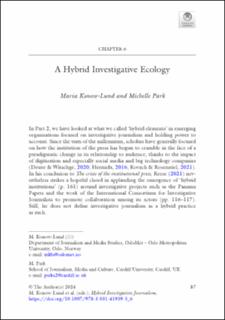A Hybrid Investigative Ecology
| dc.contributor.author | Konow Lund, Maria | |
| dc.contributor.author | Park, Michelle | |
| dc.date.accessioned | 2024-02-01T11:23:11Z | |
| dc.date.available | 2024-02-01T11:23:11Z | |
| dc.date.created | 2024-01-19T17:50:28Z | |
| dc.date.issued | 2023 | |
| dc.identifier.isbn | 978-3-031-41938-6 | |
| dc.identifier.uri | https://hdl.handle.net/11250/3115039 | |
| dc.description.abstract | In Part 2, we have looked at what we called ‘hybrid elements’ in emerging organisations focused on investigative journalism and holding power to account. Since the turn of the millennium, scholars have generally focused on how the institution of the press has begun to crumble in the face of a paradigmatic change in its relationship to audience, thanks to the impact of digitisation and especially social media and big technology companies (Deuze & Witschge, 2020; Hermida, 2016; Kovach & Rosenstiel, 2021). In his conclusion to The crisis of the institutional press, Reese (2021) nevertheless strikes a hopeful chord in applauding the emergence of ‘hybrid institutions’ (p. 161) around investigative projects such as the Panama Papers and the work of the International Consortium for Investigative Journalists to promote collaboration among its actors (pp. 116–117). Still, he does not define investigative journalism as a hybrid practice as such. | en_US |
| dc.language.iso | eng | en_US |
| dc.relation.ispartof | Hybrid Investigative Journalism | |
| dc.rights | Navngivelse 4.0 Internasjonal | * |
| dc.rights.uri | http://creativecommons.org/licenses/by/4.0/deed.no | * |
| dc.title | A Hybrid Investigative Ecology | en_US |
| dc.type | Chapter | en_US |
| dc.description.version | publishedVersion | en_US |
| cristin.ispublished | true | |
| cristin.fulltext | original | |
| cristin.qualitycode | 2 | |
| dc.identifier.cristin | 2230910 | |
| dc.source.pagenumber | 87-93 | en_US |
Tilhørende fil(er)
Denne innførselen finnes i følgende samling(er)
-
Publikasjoner fra Cristin [3201]
-
SAM - Institutt for journalistikk og mediefag [333]
SAM - Department of Journalism and Media Studies

